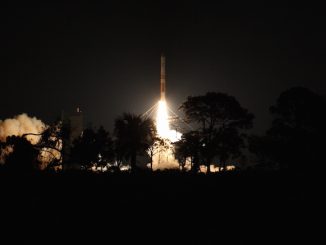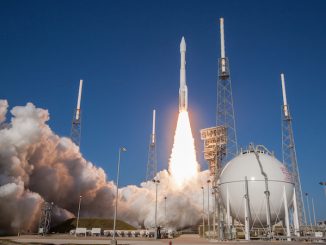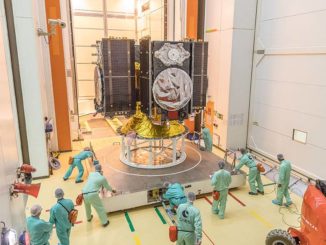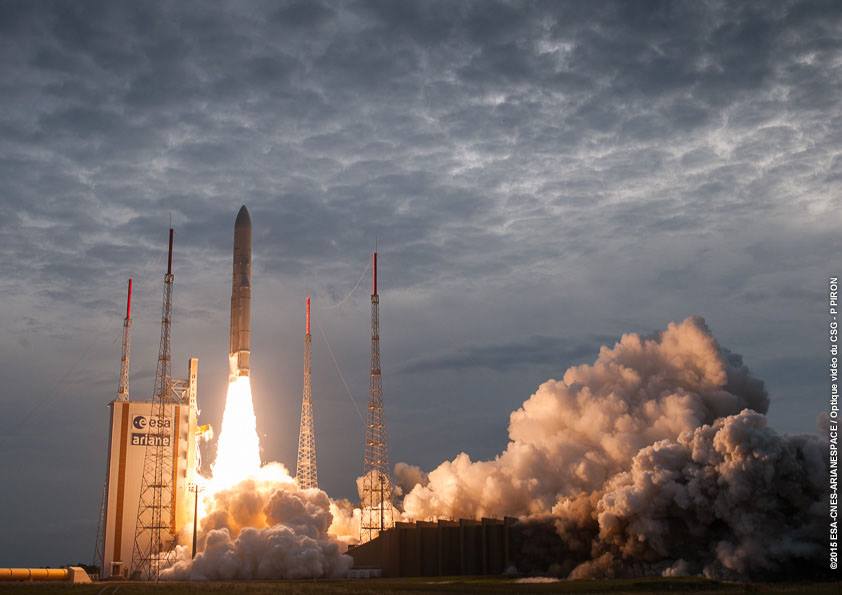
A hefty European-built satellite destined to broadcast high-definition television to the Middle East and a U.S.-made relay station programmed to serve Latin America and North Atlantic air routes soared into space Thursday aboard an Ariane 5 rocket.
Owned by Eutelsat and Intelsat, the spacecraft rocketed into orbit cocooned inside the nose shroud of an Ariane 5 booster launched at 2034 GMT (4:34 p.m. EDT) Thursday from the European-run space center in French Guiana.
The launch was held on the ground 24 minutes to resolve a problem from earlier in the countdown that delayed the start of fueling.
Under the guidance of a computer-controlled countdown sequencer, the Ariane 5 lit its liquid-burning Vulcain 2 main engine and a pair of slender solid rocket boosters to fire away from the tropical spaceport on the northern shore of South America.
Quickly turning east over the Atlantic Ocean, the Ariane 5 surpassed the speed of sound in 48 seconds propelled by 2.9 million pounds of thrust from its high-energy propulsion system.
The twin solid rocket boosters consumed their fuel and released about two minutes after liftoff, followed shortly by the jettison of the payload fairing covering the Eutelsat and Intelsat satellites.
The rocket’s main stage drained 380,000 pounds — about 173 metric tons — of super-chilled liquid hydrogen and liquid oxygen in about nine minutes, then gave way to an upper stage engine to finish the task of placing the two satellite passengers into the correct orbit.
The second stage’s cryogenic engine switched off about 25 minutes into the mission, then the rocket’s fine pointing thrusters oriented the stage to release the Eutelsat 8 West B satellite, a high-definition TV satellite, and then Intelsat 34, a multi-purpose craft to replace two aging platforms in Intelsat’s fleet.
The orbital injection was spot-on, according to Arianespace, the French operator of the Ariane 5 rocket.
“Arianespace is happy to celebrate tonight the Ariane 5’s 67th success in a row with the first two commercial customers of our heavy-lift vehicle — Eutelsat and Intelsat,” said Stephane Israel, Arianespace’s chairman and chief executive.
The Ariane 5 was targeting a geostationary transfer orbit with a high point of 22,273 miles, a low point of 156 miles and an inclination of 4.7 degrees to the equator.
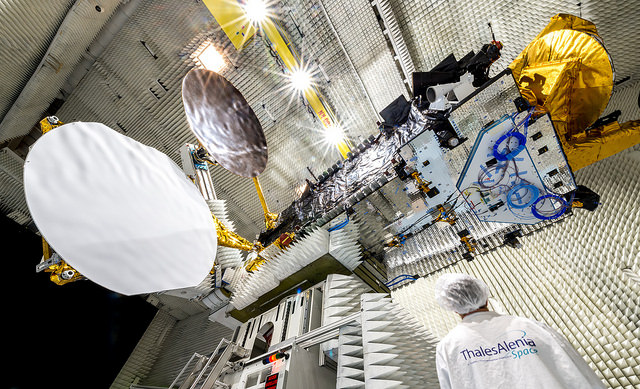
The Eutelsat 8 West B satellite, based on Thales Alenia Space’s Spacebus 4000 C4 platform, will reach a circular 22,300-mile-high geostationary orbit within six days, aiming to begin operational service for Eutelsat by the beginning of October.
“It’s a huge relief,” said Michel Azibert, Eutelsat’s deputy CEO and chief commercial and development officer. “Of course, we know Arianespace has a reputation for being extremely reliable, but it’s always a tense moment for us.”
The spacecraft weighed 12,747 pounds — nearly 5.8 metric tons — at liftoff and is designed for a 15-year service life.
“It’s a satellite which is next to 6 tons,” Azibert said in remarks after the launch. “It carries both Ku-band television services and C-band telecommunications services. The Ku-band services are for the Middle East and North Africa region.”
Eutelsat 8 West B is named for its final operating post along the equator at 8 degrees west longitude, where the satellite’s 40 Ku-band transponders will beam direct-to-home high-definition and Ultra HD television to millions of homes in the Middle East and North Africa.
Ten C-band transponders will serve telecommunications customers in Africa and South America, according to Paris-based Eutelsat.
“The launch of Eutelsat 8 West B opens a new chapter in the growth story of the leading neighborhood in the Middle East and North Africa occupied by Eutelsat and Nilesat satellites,” Azibert said in a written statement. “Through steady investment in high-performance satellites and the fastest growing audience in the region we have gained the trust of market-leading media groups and service providers who look to 7/8 degrees west to accelerate their growth.”
The new satellite replaces coverage offered by Eutelsat 8 West A — launched on Ariane 4 in 2001 — and Eutelsat 8 West C — launched on the first Atlas 5 flight in 2002. The aging craft will be re-deployed to other missions.
“Eutelsat 8 West B equips us to meet demand to broadcast more digital and high-definition content to over 250 million viewers and gives us more coverage options, enabling broadcasters to target their audience,” Azibert said. “These features underpin the 100 percent success in sales of capacity connected to footprints serving a vast region stretching from Morocco to the Gulf.”
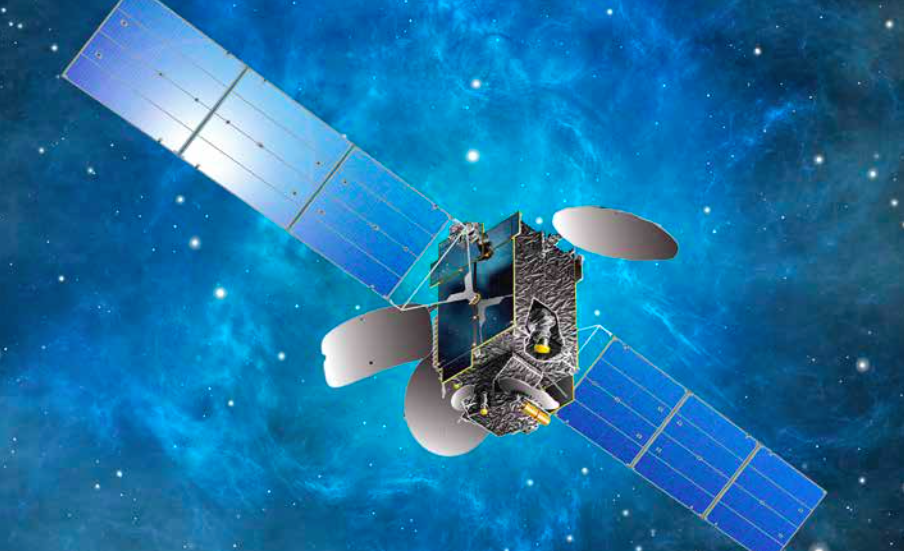
The Intelsat 34 satellite, which rode in the lower berth of the Ariane 5 launcher, will also reach its operational position in geostationary orbit six days after liftoff.
“Intelsat 34 is the 55th satellite launched by Arianespace for Intelsat,” Israel said. “Our cooperation with Intelsat started more than 30 years ago, as well as for Eutelsat, with the launch of Intelsat 507 in October 1983 on Ariane 1.”
Built on Space Systems/Loral’s 1300-series satellite platform, Intelsat 34 is heading for 55.5 degrees west, where it will broadcast television to homes in Brazil, distribute video programming for companies like HBO and Fox across Latin America, and beam broadband services to travelers aboard airplanes and ships crossing the North Atlantic Ocean.
“It’s a great day, a beautiful launch,” said Thierry Guillemin, chief technical officer for Intelsat, which is headquartered in Washington, D.C. “Even after being in this business for 30 years, it still gives you a thrill to watch a launch, and of course, even more when it’s your satellite.”
Intelsat 34 is the 50th Loral-built satellite launched for Intelsat.
“Fifty is a very fitting number,” Guillemin said. “Fifty years ago is when the first Intelsat spacecraft was launched. It was called Early Bird, and this satellite, four years later, broadcast the first steps of Neil Armstrong the moon.”
With a launch mass of 7,275 pounds — about 3.3 metric tons — Intelsat 34 is a replacement for the Intelsat 27 spacecraft lost aboard a Sea Launch mission in 2013. It will take the place of Intelsat’s Galaxy 11 and Intelsat 805 spacecraft in orbit, the company’s last two relay stations launched before 2000.
“In a few weeks, Intelsat 34 will start distributing video and media comment to millions over Latin America, as well as Internet access and TV programs over the Atlantic for those who are lucky enough to travel often between, for instance, the U.S. and Europe,” Guillemin said.
“Our team in Washington will now raise the orbit of the spacecraft within a few days to geostationary altitude, and then test the satellite,” Guillemin said. “By the first of October, we should be ready to start commercial service.”
Thursday’s launch marked the fourth of six Ariane 5 missions planned by Arianespace this year, and the seventh of 12 flights scheduled across the French operator’s fleet.
Next is a Soyuz rocket launch set for Sept. 10 with the next two satellites for Europe’s Galileo navigation network, followed Sept. 30 by the next Ariane 5 flight with communications satellites for Argentina and Australia.
Before the end of the year, Arianespace plans another Ariane 5 launch in early November with another dual-payload for Saudi Arabia’s telecom operator Arabsat and the Indian Space Research Organization.
The lightweight solid-fueled Vega launcher has a mission planned for no earlier than Nov. 27 with the European Space Agency’s LISA Pathfinder gravity wave science probe, and another Soyuz launch is targeted for December with the next pair of Galileo positioning platforms.
Email the author.
Follow Stephen Clark on Twitter: @StephenClark1.

